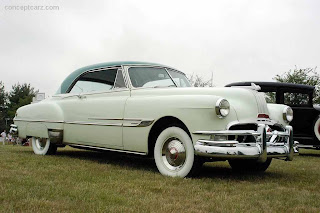
As World War II ground to a halt in the late 1940's, production once again resumed at the Pontiac Motors Division of General Motors. Commissioned by the Government in 1942, Pontiac had assisted in the creation of rocket bombs throughout the duration of the war. Embroiled in the midst of the hysteria of a Communist Witch Hunt, in 1951, America also found itself of the long-lasting Korean War. At this time, American automobiles were stuck in the rut between the tank-like creations of the 40's, and the rocket-talifin-like stylistic barges of the mid 1950's. The American public was exactly ready for ‘compacts' yet.
Pontiac's were always viewed as reliable, value-packed, yet totally predictable in appearance prior to World War II. For those that find themselves in the middle income bracket, the 'Middle Car' was best suited for middle aged, middle-of-the-road buyers. Very clearly out of the loop compared to the sporty boom of the Post War Period, Pontiac was unfortunately missing out on the youth market.
This all changed in 1949, when Pontiac realized that to meet the market demand they would need to step it up. Developing newly designed bodies, these newly released vehicles came with lower fender lines and longer hoods. An instantaneous hit, the new ‘youthful' styling in small rear fender humps that resembled small wheel's, were popular with the American public.
American auto sales had rocketed to 5.1 million by 1949. With the best road system at their disposal, Americans were ready for new automobiles that rid themselves of the tired 1940's style and expressed their optimism and confidence. Propelled by advertising and financed by America's post-war affluence, the 1950's revolution in automotive styling and engineering soared.

Not much variation in the Pontiac lineup from where it left off in 1942, post-war production began again in 1946. Following several years of updates to fit the general public's needs, Pontiac production soars, making 1950 the best year in automotive industry to date. The Chieftain Super Deluxe Catalina Coupe was showcased in 1950.
Produced by the Pontiac Motors Division of General Motors from 1949 until 1958, the Pontiac Chieftain was introduced. Five years later, the Pontiac Star Chief Custom Safari was unveiled to the public. A variation on the Chieftain Super Deluxe Catalina Coupe, the Pontiac Star Chief Catalina Coupe was introduced in 1956.
Part of Pontiac's full-sized automobile line, the Catalina was a name that was initially used strictly to denote hardtop body styles. Originally appearing in the 1950 Chieftain Eight and DeLuxe lines, the Catalina eventually became its own separate and unique model in 1959, as the ‘entry level' full-size Pontiac.
The top of the line model at the time for Pontiac, the 1950 Chieftain Hardtop, Series 25/27, was also dubbed the name Catalina. Featuring pillar-less design in both the door and window areas, along with the top-grade convertible appointments, these ‘hard-top convertibles' were both airy and had a hard to resist sporty-feeling.
Rather than having a fixed-roof design, these models offered the appeal of the sport car without the drawbacks and expense that was normally associated with convertible top vehicles. From 1950 to 1958, all Pontiac hardtops were designated 'Catalina' with the exception of the 58 Bonneville hardtop. At the time of its debut, the Chieftain Hardtop was powered by a straight-8 ‘flathead' engine, before eventually receiving Pontiac's new V8, the 287 in³ OHV four years later.
The Chieftain name for Pontiac's entry level model was dropped in 1959, and renamed Catalina. The once top-line Star Chief was dropped to mid-line status as the Bonneville nameplate was expanded to encompass a full series that included sedans, coupes, convertibles and Safari station wagons. The Catalina, as well as the more luxurious Bonneville, was eventually discontinued following the 1981 model year as part of GM's continued downsizing program, Pontiac strove to abandon the full-sized car market.
An equivalent of the Catalina model was produced by GM of Canada called Laurentian, and was initially the mid-priced Pontiac. Placed between the budget-priced Strato-Chief and the de luxe Parisenne, the Laurentian's utilized a full-sized Chevrolet chassis, drive trains, and other various parts, Pontiac fenders and instrument panels. Though almost identical in appearance to the U.S. Pontiac Catalina, the Laurentian had much more in common with a Chevy Impala. Only produced for the Canadian market, Laurentians were never sold in the U.S., and were available in all the body styles used for the U.S. Catalina, including the hardtops.
In 1951, a total of 1,382 units were produced, while the numbers dropped to 984 in 1952. The numbers rose once again in 1953 to 1,324 units produced.
Source: Internet
